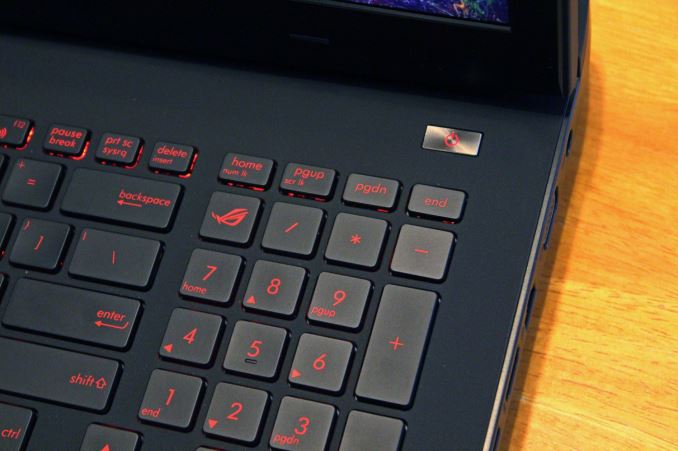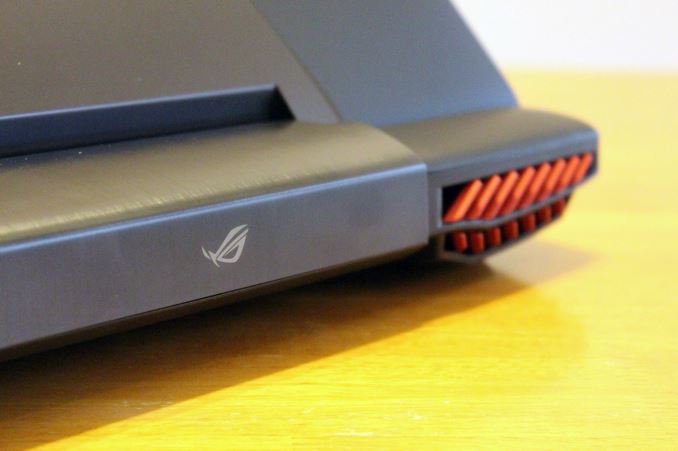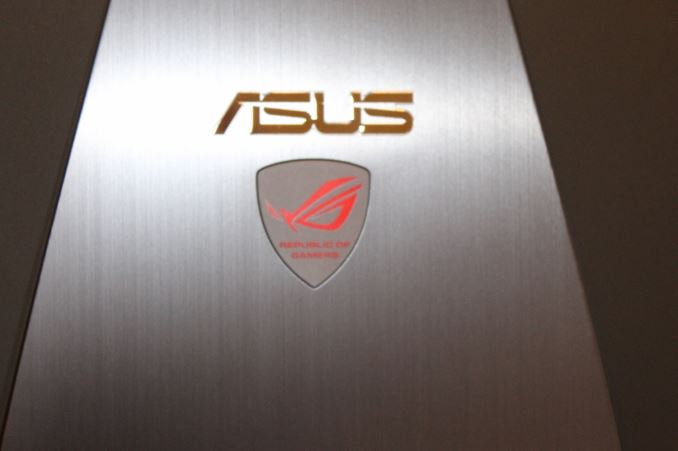The ASUS Republic of Gamers G751 Review: G-SYNC Comes To The Notebook Computer
by Brett Howse on July 29, 2015 8:30 AM ESTFinal Words
Evaluating the ASUS G751 is my first opportunity to use G-SYNC when gaming, and to that end G-SYNC has certainly lived up to its billing. Some of that would also be the very powerful hardware that ASUS has packed into the G751. The GTX 980M continues to impress, and in a device of this size, cooling is not an issue. The other part of the smoothness when gaming though is ASUS’s decision to include a 75 Hz IPS panel. The combination of G-SYNC with this panel makes practically any gaming scenario a silky smooth experience.
The package has some hits and misses. The keyboard and trackpad are quite good, and I’ve already praised the IPS panel which in addition to the 75 Hz refresh rate, has decent color accuracy and contrast. It’s a big step up from the TN panels which can still be found in some gaming notebooks. ASUS has also included plenty of connections including four USB 3.0 ports and a network port. On the miss side is, at least in my opinion, the styling. The G751 seems to have been styled against gaming laptops from a couple of years ago, and hasn’t moved to a sleeker form factor with more premium materials than plastic. Some of that may have been costs though, since ASUS is trying to offer a powerful system at a better price.
The thicker form factor and massive weight of this notebook certainly reduce its portability, and that is further hampered by the poor battery life, which is dragged down by the lack of Optimus support. But for the target audience this is going to likely be the least important criticism. The benefit of no Optimus is G-SYNC support, which on a device like this is certainly the right trade-off.
At this point, all of the hardware inside of the G751 is pretty well known, but that doesn’t take back what it does. The Core i7-4720HQ processor is plenty powerful for most tasks, and while it would have been nice to see ASUS upgrade it to the Broadwell parts, it’s hard to fault them since the quad-core Broadwell upgrade was pretty late in coming. The NVIDIA GTX 980M is the star of the show, as it tends to be, offering some pretty impressive gaming performance in a portable notebook. ASUS has also outfitted the G751 with 24 GB of memory in this model, and they offer an upgrade with 32 GB as well. The included storage is very fast, and it’s great to see them make the move to PCIe based storage. The XP941 is a very quick drive and storage speeds should not ever be an issue. For those that need more flash storage, ASUS does offer a 512 GB version as well as the 256 GB model sampled. The days of the optical drive seem to be numbered, but it’s handy to have a Blu-Ray burner available, and I’ve already used it a few times.
One of the strongest features of the G751 is the cooling system, which seems to pretty easily handle the heat output of the CPU and GPU, but it does this while maintaining a relatively quiet sound levels. It really is quite amazing to be gaming on a system this powerful, and while you can hear the fans, the output and frequency are both low enough to not really bother you. Most gaming laptops are almost always going to need headphones, but the G751 is certainly the quietest gaming notebook that I have encountered.
Overall, I’ve really enjoyed my time with the ASUS G751. It offers plenty of power, a good display, and is among the first laptops to offer the supurb game smoothing capabilities of G-SYNC. It is certainly not inexpensive at $2150 as tested, to $2650 (MSRP) with a faster CPU and double the SSD storage, but it comes in at a good price for a system with this much performance. Online, you can find the as-tested model for $1900 at Amazon, which is a good chunk of change less than the MSRP and really adds to the value of this offering. To me, the one real downside is the styling, but that’s one thing that is really up to the individual. The combination of G-SYNC, a 75 Hz IPS panel, and the GTX 980M make this an incredibly potent gaming notebook.













52 Comments
View All Comments
Meaker10 - Wednesday, July 29, 2015 - link
Indeed, the only way to get around this is to do what MSI have done and have a manual switch and on reboot move the traces over and run in IGP mode (without G-sync of course).Asus also only had the later G750 with optimus, before they actually avoided it generally in their 17 inch models. So really for asus the optimus models were a blip rather than a trend.
nerd1 - Friday, July 31, 2015 - link
Many laptops had hardware mux to switch GPU pre-optimus era (alienware had one) which is a way better solution than optimus.nightbringer57 - Wednesday, July 29, 2015 - link
As a matter of fact, everyone has been building some non optimus notebooks all the time.The Optimus technology requires the screen to be directly driven by the integrated GPU. Some custom technologies made by GPU manufacturers require the screen to be driven by the GPU himself. That's why the 3D laptops never sold, because Nvidia's 3D technology requires the screen to be driven by the nvidia GPU directly, so you can't have an Optimus-enabled 3D screen laptop (well, at least using nvidia 3D).
The same problem is true for G-Sync. So you can't technically have G-sync and optimus on the same laptop.
BMNify - Wednesday, July 29, 2015 - link
Exactly, the optimus tech even effects VR and you can't drive VR with igpu, many high end laptops are now coming without optimus due to customer demand.BMNify - Wednesday, July 29, 2015 - link
Optimus tech is reviled in the hardcore gaming community and gaming forums who pay $2000 plus for gaming laptops, many top-end gaming laptops have no optimus due to Customer demand !!Notmyusualid - Saturday, August 1, 2015 - link
^ This is true.Many don't buy a machine due to the very fact that Optimus is there.
However, I have a Dell M3800 HD4600/K1100M that has no issue with it.
boeush - Wednesday, July 29, 2015 - link
OK, bit why would anyone buy this now, when Skylake is right around the corner? Wait another couple of months, and an equivalent model with a better CPU and DDR4 is all but guaranteed by the holiday shopping season. Or, at the very least, this particular model will be selling at deep discounts by then...boeush - Wednesday, July 29, 2015 - link
Not to mention, a premium laptop this far into 2015, and with not a single USB 3.1 port? Tsk, tsk...meacupla - Wednesday, July 29, 2015 - link
because, you buy it when you need it, not when there is something new 'in a couple of months'.A week, sure, that's not a long wait, but 2 months to launch means you're going to be waiting another 6 months until the replacement for this type of gaming laptop to appear on the market.
boeush - Wednesday, July 29, 2015 - link
According to various leaks, Skylake H is launching in October. Skylake T (low voltage 35W i7 6700) is also launching about then or even sooner.Given that, why would anyone NOT expect all brands to refresh models with Skylake by Black Friday?? Any brand that fails to do that, is going to lose out huge this year.
So sure, retail availability of bixed CPUs is October, but I'll bet all the OEMs have had samples under NDA since spring, and are working to deliver updated models on the same day as the CPU launch.